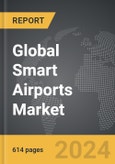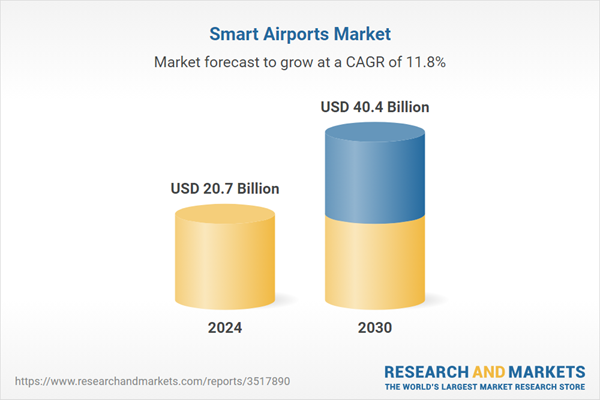Global Smart Airports Market - Key Trends & Drivers Summarized
Smart airports represent the future of aviation infrastructure, leveraging advanced technologies to enhance efficiency, safety, and passenger experience. These airports integrate various systems and applications, including IoT (Internet of Things), artificial intelligence (AI), and big data analytics, to create a seamless and interconnected environment. For instance, IoT devices are used to monitor and manage airport operations in real time, from baggage handling and security checks to lighting and HVAC systems. AI-driven solutions help in predictive maintenance of equipment, ensuring minimal downtime and reducing operational costs. Additionally, facial recognition and biometric systems streamline passenger processing, reducing wait times and enhancing security. These technologies collectively contribute to more efficient airport management and a smoother, more enjoyable travel experience for passengers.The implementation of smart technologies in airports extends to various facets of airport operations and passenger services. For example, advanced navigation systems guide passengers through the terminal, providing real-time updates on flight statuses, gate changes, and queue lengths at security and immigration checkpoints. Smart parking solutions enable travelers to find available parking spaces quickly and even reserve spots in advance. Furthermore, the use of digital twins - virtual replicas of physical airport environments - allows operators to simulate different scenarios and optimize layouts, crowd management, and emergency responses. Retail and hospitality services within airports are also enhanced through personalized marketing and seamless payment options, driven by data analytics and mobile applications. These innovations not only improve operational efficiency but also significantly elevate the passenger experience by offering convenience, comfort, and personalized services.
The growth in the smart airports market is driven by several factors, including rising passenger traffic, increasing demand for operational efficiency, and advancements in technology. The continuous growth in global air travel necessitates the expansion and modernization of airport infrastructure to handle higher volumes of passengers and flights. This demand for scalability and efficiency propels the adoption of smart technologies that optimize resource utilization and streamline operations. Additionally, the increasing focus on enhancing passenger experience and satisfaction drives airports to invest in cutting-edge solutions that offer personalized and efficient services. Advancements in IoT, AI, and data analytics provide the necessary tools to implement these solutions effectively. Furthermore, regulatory requirements for enhanced security and sustainability push airports towards smarter, more integrated systems. As these factors converge, the smart airports market is set for substantial growth, driven by the need for efficient, secure, and passenger-friendly airport environments.
Report Scope
The report analyzes the Smart Airports market, presented in terms of market value (USD). The analysis covers the key segments and geographic regions outlined below.- Segments: Location (Terminal Side, Airside, Landside); Technology (Ground Handling Control, Security Systems, Air / Ground Traffic Control, Communication Systems, Other Technologies); End-Use (Aeronautical Operations, Non-Aeronautical Operations).
- Geographic Regions/Countries: World; USA; Canada; Japan; China; Europe; France; Germany; Italy; UK; Spain; Russia; Rest of Europe; Asia-Pacific; Australia; India; South Korea; Rest of Asia-Pacific; Latin America; Argentina; Brazil; Mexico; Rest of Latin America; Middle East; Iran; Israel; Saudi Arabia; UAE; Rest of Middle East; Africa.
Key Insights:
- Market Growth: Understand the significant growth trajectory of the Terminal Side segment, which is expected to reach US$26 Billion by 2030 with a CAGR of 11.4%. The Airside segment is also set to grow at 13.1% CAGR over the analysis period.
- Regional Analysis: Gain insights into the U.S. market, valued at $5 Billion in 2024, and China, forecasted to grow at an impressive 15.9% CAGR to reach $4.8 Billion by 2030. Discover growth trends in other key regions, including Japan, Canada, Germany, and the Asia-Pacific.
Why You Should Buy This Report:
- Detailed Market Analysis: Access a thorough analysis of the Global Smart Airports Market, covering all major geographic regions and market segments.
- Competitive Insights: Get an overview of the competitive landscape, including the market presence of major players across different geographies.
- Future Trends and Drivers: Understand the key trends and drivers shaping the future of the Global Smart Airports Market.
- Actionable Insights: Benefit from actionable insights that can help you identify new revenue opportunities and make strategic business decisions.
Key Questions Answered:
- How is the Global Smart Airports Market expected to evolve by 2030?
- What are the main drivers and restraints affecting the market?
- Which market segments will grow the most over the forecast period?
- How will market shares for different regions and segments change by 2030?
- Who are the leading players in the market, and what are their prospects?
Report Features:
- Comprehensive Market Data: Independent analysis of annual sales and market forecasts in US$ Million from 2024 to 2030.
- In-Depth Regional Analysis: Detailed insights into key markets, including the U.S., China, Japan, Canada, Europe, Asia-Pacific, Latin America, Middle East, and Africa.
- Company Profiles: Coverage of players such as Amadeus IT Group, S.A., Ascent Technology, Inc., Cisco Systems, Inc., Daifuku Co., Ltd., Ericsson AB and more.
- Complimentary Updates: Receive free report updates for one year to keep you informed of the latest market developments.
Some of the 70 companies featured in this Smart Airports market report include:
- Amadeus IT Group, S.A.
- Ascent Technology, Inc.
- Cisco Systems, Inc.
- Daifuku Co., Ltd.
- Ericsson AB
- Honeywell Building Solutions, Inc.
- Huawei Technologies Co., Ltd.
- Indra Sistemas, S.A.
- International Business Machines Corporation (IBM)
- Leonardo S.p.A.
- NEC Corporation of America
- QinetiQ Group plc
- RESA Airport Data Systems SAS
- Sabre GLBL, Inc.
- Siemens AG
- SITA SA
- Thales S.A.
- Vanderlande Industries B.V.
- Veovo
- Wipro Limited
This edition integrates the latest global trade and economic shifts into comprehensive market analysis. Key updates include:
- Tariff and Trade Impact: Insights into global tariff negotiations across 180+ countries, with analysis of supply chain turbulence, sourcing disruptions, and geographic realignment. Special focus on 2025 as a pivotal year for trade tensions, including updated perspectives on the Trump-era tariffs.
- Adjusted Forecasts and Analytics: Revised global and regional market forecasts through 2030, incorporating tariff effects, economic uncertainty, and structural changes in globalization. Includes historical analysis from 2015 to 2023.
- Strategic Market Dynamics: Evaluation of revised market prospects, regional outlooks, and key economic indicators such as population and urbanization trends.
- Innovation & Technology Trends: Latest developments in product and process innovation, emerging technologies, and key industry drivers shaping the competitive landscape.
- Competitive Intelligence: Updated global market share estimates for 2025, competitive positioning of major players (Strong/Active/Niche/Trivial), and refined focus on leading global brands and core players.
- Expert Insight & Commentary: Strategic analysis from economists, trade experts, and domain specialists to contextualize market shifts and identify emerging opportunities.
Table of Contents
Companies Mentioned (Partial List)
A selection of companies mentioned in this report includes, but is not limited to:
- Amadeus IT Group, S.A.
- Ascent Technology, Inc.
- Cisco Systems, Inc.
- Daifuku Co., Ltd.
- Ericsson AB
- Honeywell Building Solutions, Inc.
- Huawei Technologies Co., Ltd.
- Indra Sistemas, S.A.
- International Business Machines Corporation (IBM)
- Leonardo S.p.A.
- NEC Corporation of America
- QinetiQ Group plc
- RESA Airport Data Systems SAS
- Sabre GLBL, Inc.
- Siemens AG
- SITA SA
- Thales S.A.
- Vanderlande Industries B.V.
- Veovo
- Wipro Limited
Table Information
| Report Attribute | Details |
|---|---|
| No. of Pages | 614 |
| Published | October 2025 |
| Forecast Period | 2024 - 2030 |
| Estimated Market Value ( USD | $ 20.7 Billion |
| Forecasted Market Value ( USD | $ 40.4 Billion |
| Compound Annual Growth Rate | 11.8% |
| Regions Covered | Global |









